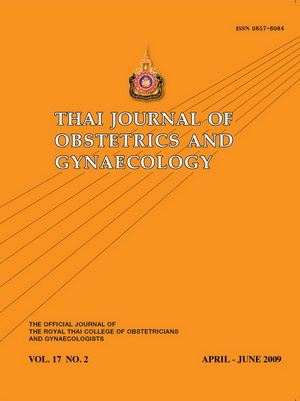Prevalence and Risk Factors of Striae Gravidarum in Primiparae
Main Article Content
Abstract
Objectives: To determine the prevalence and associated factors of striae gravidarum in Thai singleton primiparae.
Study design: Descriptive study.
Materials and methods: Two hundred and seventy-two primiparous women who had delivered after 20 weeks of gestation at Bangkok Metropolitan Administration Medical College and Vajira Hospital were recruited. Data were obtained by interviewing postpartum women according to the pre-constructed questionnaires. The questionnaires were composed of four categories: general data, pregnancy data, the symptom of appearance of striae gravidarum and application of cosmetic products such as cream or lotion. The characteristics of participants with and without striae gravidarum were compared.
Results: 67.6% of the study participants developed striae gravidarum. From multivariable analysis, the most significant factor was inflammatory acne (odds ratio = 6.7, 95% confidence interval [CI] 2.3-19.7; p-value = 0.001) compared with those without acne or with non-inflammatory acne. Other significant associated factor (p-value < 0.05) were: age < 25 years (odds ratio 4.8; 95% CI 2.4-9.5), body mass index (BMI) > 25 kg/m2 (odds ratio 2.8; 95% CI 1.0-7.5), light skin color (odds ratio 2.1; 95% CI 1.1-3.9) and fetal birth weight > 3000 g (odds ratio 1.9; 95% CI 1.0-3.6).
Conclusions: The prevalence of striae gravidarum in Thai singleton primiparae was 67.6%. Inflammatory acne developed during pregnancy, younger maternal age, high pre-pregnancy BMI, light skin color, fetal weight > 3000 g were associated with striae gravidarum.


